Mandarin duck
The mandarin duck (Aix galericulata) is a perching duck species native to the East Palearctic. It is sexually dimorphic; males showing a dramatic difference from the females.[3] It is medium-sized, at 41–49 cm (16–19 in) long with a 65–75 cm (26–30 in) wingspan. It is closely related to the North American wood duck, the only other member of the genus Aix. 'Aix' is an Ancient Greek word which was used by Aristotle to refer to an unknown diving bird, and 'galericulata' is the Latin for a wig, derived from galerum, a cap or bonnet.[4] Outside of its native range, the mandarin duck has a large introduced population in the British Isles and Western Europe, with additional smaller introductions in North America.
| Mandarin duck Temporal range: [1] | |
|---|---|
 | |
| Male and female mandarin ducks at Martin Mere, UK | |
| Scientific classification | |
| Domain: | Eukaryota |
| Kingdom: | Animalia |
| Phylum: | Chordata |
| Clade: | Dinosauria |
| Class: | Aves |
| Order: | Anseriformes |
| Family: | Anatidae |
| Genus: | Aix |
| Species: | A. galericulata |
| Binomial name | |
| Aix galericulata | |
 | |
| The native range of the mandarin duck, and parts of its introduced range where it is established breeding
Breeding
Native resident
Migrant
Winter visitor
Introduced resident | |
| Synonyms | |
|
Anas galericulata Linnaeus, 1758 | |
Description
The mandarin duck is among the more diminutive types of waterfowl, with a shorter height and smaller overall body size than the dabbling ducks, and is slightly smaller than its American wood duck relatives. The adult male has a petite, red bill, large white crescent above the eye and reddish face and "whiskers". The male's breast is purple with two vertical white bars, the flanks ruddy, and he has two orange feathers at the back (large feathers that stick up similar to boat sails). The female is similar to the female wood duck, with a grayish-lavender tone to her plumage, and a white eye-ring and stripe running back from the eye. The female is paler on the underside, has a small white flank stripe, and a pale tip to its bill.[5]
Both the males and females have crests, but the purple crest is more pronounced on the male.
Like many other species of ducks, the male undergoes a moult after the mating season into eclipse plumage. When in eclipse plumage, the male looks similar to the female, but can be told apart by its bright yellow-orange or red beak, lack of any crest, and a less-pronounced eye-stripe.
Mandarin ducklings are almost identical in appearance to wood ducklings, and very similar to mallard ducklings. The ducklings can be distinguished from mallard ducklings because the eye-stripe of mandarin ducklings (and wood ducklings) stops at the eye, while in mallard ducklings it reaches all the way to the bill.
Mutations
Various mutations of the mandarin duck are found in captivity. The most common is the white mandarin duck. Although the origin of this mutation is unknown, the constant pairing of related birds and selective breeding is presumed to have led to recessive gene combinations, leading in turn to genetic conditions including leucism.
Distribution and habitat
The species was once widespread in East Asia, but large-scale exports and the destruction of its forest habitat have reduced populations in eastern Russia and in China to below 1,000 pairs in each country; Japan, however, is thought to still hold some 5,000 pairs. The Asian populations are migratory, overwintering in lowland eastern China and southern Japan.[6]
Specimens frequently escape from collections, and in the 20th century, a large, feral population was established in Great Britain; more recently, small numbers have bred in Ireland, concentrated in the parks of Dublin. Now, about 7,000 are in Britain with other populations on the European continent, the largest of which is in the region of Berlin.[7] Isolated populations exist in the United States. The town of Black Mountain, North Carolina, has a limited population,[8] and a free-flying feral population of several hundred mandarins exist in Sonoma County, California. This population is the result of several ducks escaping from captivity, then reproducing in the wild.[5] In 2018, a single bird, dubbed Mandarin Patinkin, was seen in New York City's Central Park.[9]
The habitats it prefers in its breeding range are the dense, shrubby forested edges of rivers and lakes. It mostly occurs in low-lying areas, but it may breed in valleys at altitudes of up to 1,500 m (4,900 ft). In winter, it additionally occurs in marshes, flooded fields, and open rivers. While it prefers fresh water, it may also be seen wintering in coastal lagoons and estuaries. In its introduced European range, it lives in more open habitat than in its native range, around the edges of lakes, water meadows, and cultivated areas with woods nearby.[6]
Behaviour
Compared to other ducks, mandarins are shy birds, preferring to seek cover under trees such as overhanging willows, and form smaller flocks,[10] but may become bolder as a result of becoming tame from frequent interaction with humans.
Breeding

In the wild, mandarin ducks breed in densely wooded areas near shallow lakes, marshes or ponds. They nest in cavities in trees close to water during the spring. A single clutch of nine to twelve eggs is laid in April or May. Although the male may defend the brooding female and his eggs during incubation, he himself does not incubate the eggs and leaves before they hatch. Shortly after the ducklings hatch, their mother flies to the ground and coaxes the ducklings to leap from the nest. After all of the ducklings are out of the tree, they will follow their mother to a nearby body of water.[6]
Food and feeding
.jpg.webp)
Mandarins feed by dabbling or walking on land. They mainly eat plants and seeds, especially beech mast. The species will also add snails, insects and small fish to its diet.[11] The diet of mandarin ducks changes seasonally; in the fall and winter, they mostly eat acorns and grains. In the spring, they mostly eat insects, snails, fish and aquatic plants. In the summer, they eat dew worms, small fish, frogs, mollusks, and small snakes.[12] They feed mainly near dawn or dusk, perching in trees or on the ground during the day.[6]
Threats
Predation of the mandarin duck varies between different parts of its range. Mink, raccoon dogs, otters, polecats, Eurasian eagle-owls, and grass snakes are all predators of the mandarin duck.[12] The greatest threat to the mandarin duck is habitat loss due to loggers. Hunters are also a threat to the mandarin duck, because often they are unable to recognize the mandarin in flight and as a result, many are shot by accident. Mandarin ducks are not hunted for food, but are still poached because their extreme beauty is prized.[12]
In culture
Chinese culture
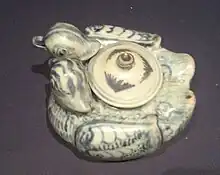
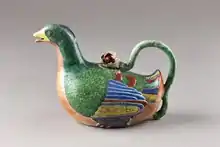
The Chinese refer to mandarin ducks as yuanyang (simplified Chinese: 鸳鸯; traditional Chinese: 鴛鴦; pinyin: yuānyāng), where 'yuan' (鴛) and 'yang' (鴦) respectively stand for male and female mandarin ducks. In traditional Chinese culture, mandarin ducks are believed to be lifelong couples, unlike other species of ducks. Hence they are regarded as a symbol of conjugal affection and fidelity, and are frequently featured in Chinese art.
A Chinese proverb for loving couples uses the mandarin duck as a metaphor: "Two mandarin ducks playing in water" (simplified Chinese: 鸳鸯戏水; traditional Chinese: 鴛鴦戲水; pinyin: yuānyāng xì shuǐ). A mandarin duck symbol is also used in Chinese weddings because in traditional Chinese lore, they symbolize wedded bliss and fidelity. Because the male and female plumages of the mandarin duck are so unalike, 'yuan-yang' is frequently used colloquially in Cantonese to mean an "odd couple" or "unlikely pair" – a mixture of two different types of the same category; for example, the drink yuanyang and yuan-yang fried rice. Mandarin ducks featured on the flag of Weihaiwei during British rule.
Korean culture
For Koreans, mandarin ducks represent peace, fidelity, and plentiful offspring. Similar to the Chinese, they believe that these ducks mate for life. For these reasons, pairs of wooden-carved mandarin ducks called wedding ducks are often given as wedding gifts and play a significant role in Korean marriage.[13]
Gallery
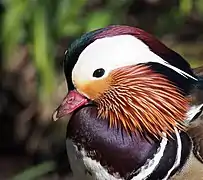 Portrait of a male at Martin Mere, England
Portrait of a male at Martin Mere, England.JPG.webp) Mandarin drake
Mandarin drake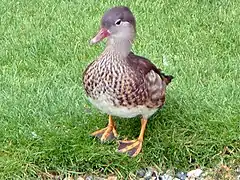 Drake in eclipse plumage
Drake in eclipse plumage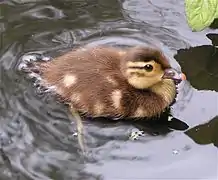 Duckling
Duckling Mating couple
Mating couple- Drake during moulting prior to eclipse plumage
 Egg, Museum Wiesbaden collection
Egg, Museum Wiesbaden collection A male in Łazienki Park, Warsaw
A male in Łazienki Park, Warsaw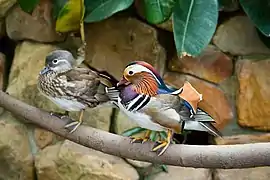 Male and female mandarin ducks on branch
Male and female mandarin ducks on branch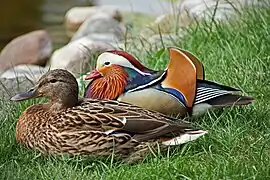 A male mandarin and a female mallard in Stara Iwiczna, Poland
A male mandarin and a female mallard in Stara Iwiczna, Poland A pair of incense boxes shaped like mandarin ducks
A pair of incense boxes shaped like mandarin ducks.jpg.webp) A male mandarin duck in Central Park, New York
A male mandarin duck in Central Park, New York
References
- Harrison, C. J. O. (1979). "Birds of the Cromer Forest Bed series of the East Anglian Pleistocene". Transactions of the Norfolk & Norwich Naturalists' Society. 25 (1).
- BirdLife International (2018). "Aix galericulata". IUCN Red List of Threatened Species. 2018: e.T22680107A131911544. doi:10.2305/IUCN.UK.2018-2.RLTS.T22680107A131911544.en. Retrieved 19 November 2021.
- Johnsgard, Paul (1965). Handbook of Waterfowl Behavior. Comstock Pub. Associates. p. 378. ISBN 9780801402074.
- Jobling, James A (2010). The Helm Dictionary of Scientific Bird Names. London: Christopher Helm. pp. 37, 169. ISBN 978-1-4081-2501-4.
- Shurtleff, Lawton; Savage, Christopher (1996). The Wood Duck and the Mandarin: The Northern Wood Ducks. University of California Press. ISBN 0-520-20812-9.
- Madge, Steve; Burn, Hilary (1987). Wildfowl: An identification guide to the ducks, geese and swans of the world. London: Christopher Helm. pp. 188–189. ISBN 0-7470-2201-1.
- Blankennagel, Jens (11 January 2008). "Kunterbunte Einwanderer". Berliner Zeitung (in German). Retrieved 3 February 2012.
- "Let's Talk About Birds: Mandarin Ducks". post-gazette.com. 8 February 2012. Archived from the original on 13 June 2015.
- "Rare Mandarin Duck Makes A Splash in Central Park". CBS New York. 31 October 2018. Retrieved 3 November 2018.
- "Mandarin duck | The Wildlife Trusts". www.wildlifetrusts.org. Retrieved 14 January 2021.
- "Mandarin Duck Fact Sheet". Lincoln Park Zoo.
- "Mandarin Duck". Honolulu Zoo. Archived from the original on 31 May 2012. Retrieved 5 February 2012.
- Chira, Susan (5 October 1986). "The Happy Couple: Korean Wedding Ducks". The New York Times. Retrieved 30 June 2013.
- "皇太子黄丹袍姿" (in Japanese). Costume Museum. Retrieved 12 August 2023.
Further reading
- Simko-Bednarski, Evan (2 November 2018). "A rare Mandarin duck is hanging out in NYC's Central Park and nobody knows how it got there". CNN. Retrieved 2 November 2018.
